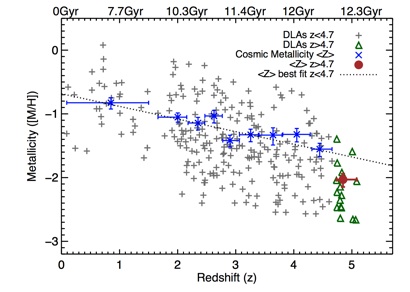The Rapid Decline in Metallicity of Damped Ly-alpha Systems at z~5

We present evidence that the cosmological mean metallicity of neutral atomic hydrogen gas shows a sudden decrease at z>4.7 down to <Z>=-2.03(+0.09-0.11), which is 6 sigma deviant from that predicted by a linear fit to the data at lower redshifts. This measurement is made possible by the chemical abundance measurements of 8 new damped Ly-alpha (DLA) systems at z>4.7 observed with the Echellette Spectrograph and Imager on the Keck II telescope, doubling the number of measurements at z>4.7 to 16. The sudden decrease in metallicity is possibly due to the lower ultra-violet radiation field and higher density at high redshift increasing the neutral fraction of gas inside halos, such as cold flows. This would result in a new population of presumably lower metallicity DLAs, with an increased contribution to the DLA population at higher redshifts resulting in a reduced mean metallicity. While the comoving metal mass density of DLAs is flat out to z~4.3, there is evidence of a possible decrease at z>4.7. Such a decrease is expected, as otherwise most of the metals from star-forming galaxies would reside in DLAs by z~6. While the metallicity is decreasing at high redshift, the contribution of DLAs to the total metal budget of the universe increases with redshift, with DLAs at z~4.3 accounting for ~20% as many metals as produced by Lyman break galaxies.
Postdoctoral work at Caltech (IPAC)







